Description of Test
This is a much-adapted version of the Mathematics web test that was used in the 12 Year study. The following adaptations were made:
- Only the "understanding number" subtest has been retained from the 12 year version
- Within this subtest, some easier items used at age 12 were dropped, and some harder items have been added
- The total number of items is reduced to 18
- The branching and discontinue rules have been modified
- Validation rules have been introduced at the item level, to ensure that twins can only enter appropriate forms of response
- An on-screen calculator is shown in some items (7, 8, 16, 17) that require the use of a calculator
The test consists of a series of mathematics questions. The questions are presented in full in the table below.
The question format varies from item to item. Some questions require a numerical response, where the twin has to type a number in a box then click on "OK". In other questions, a set of possible responses (consisting of pictures, text or numbers) are presented on screen, and the twin has to select one or more answers. In these cases, if one answer is required then the twin simply clicks on it; if two or more answers are required, the twin clicks on the chosen responses then clicks on "OK".
Test Rules
- Scoring
For each question, the correct response is given a score of 1, and any incorrect response is given a score of 0. Any question omitted due to the discontinue rule is given a score of 0. If at any point in a sub-test a twin branches up, and does not subsequently branch down again, then any lower items skipped due to branching are credited towards the score, as though they had been answered correctly. The total test score is the sum of the item scores. The maximum total score for the test is 18. - Branching rules
- For all twins, the test starts with items 7 and 8, at an
intermediate level of difficulty. These two items are the
first branch point. Then:
- If both items 7 and 8 are answered incorrectly, branch down to the basal point at item 1.
- If one of items 7 and 8 is answered correctly, and one incorrectly, move on to the basal point at item 9. Credit items 1 to 6 as if they had been answered correctly.
- If both items 7 and 8 are answered correctly, branch up
to the
second branch point at items 13 and 14.
Credit items 1 to 6 as if they had been answered correctly.
Then:
- If both items 13 and 14 are answered incorrectly, branch back down to the basal point at item 9.
- If one or both of items 13 and 14 are answered correctly, move on to the basal point at item 15. Credit items 9 to 12 as if they had been answered correctly.
- At a basal point (item 1, 9 or 15), the twin proceeds with the remaining test items (in ascending order of sub-test item number) either until the end of the test is reached, or until the twin discontinues the test (see below).
- No item is presented more than once, and no further branching
occurs after a basal point has been reached. Here are example item
sequences illustrating the main branching routes through the test
(without the discontinue rule applying):
- 7 wrong, 8 wrong (branch down), 1, 2, 3, 4, 5, 6, 9, 10, 11, 12, 13, 14, 15, 16, 17, 18
- 7 wrong, 8 correct, 9, 10, 11, 12, 13, 14, 15, 16, 17, 18 (credit 1-6)
- 7 correct, 8 correct (branch up), 13 wrong, 14 wrong (branch down), 9, 10, 11, 12, 15, 16, 17, 18 (credit 1-6)
- 7 correct, 8 correct (branch up), 13 correct, 14 wrong, 15, 16, 17, 18 (credit 1-6 and 9-12)
- For all twins, the test starts with items 7 and 8, at an
intermediate level of difficulty. These two items are the
first branch point. Then:
- Discontinue rule
Discontinue the test after two consecutive items are answered incorrectly (with zero score). Note that this rule does not apply while in a branch point: if the two items of a branch point are incorrect, then a downward branch occurs rather than discontinuing. The discontinue rule only applies after a basal point has been reached. - Timeout rule
A timeout of 5 minutes applies to each item. After 5 minutes with no response, the item is forfeited with zero score, and a "next item" screen appears. On resuming the test, the twin is taken to the next item in sequence as described above. - Validation rules
All items have some kind of validation rule, to ensure that appropriate forms of response are given and to prevent twins from clicking through without responding. There are several types of rule, depending on the response format; see the table of items below for further details.
Item Variables
The item variables relating to the Understanding Number test, as listed in the table below, were generated automatically by programs on the web server during the course of the test. Note that the dataset only includes data for completed tests. If a twin started the test but left it unfinished, then the data for the test were not used.
In most cases the values of these variables have been left unaltered, although some have been recoded during data cleaning as follows. See the web data cleaning page for further details.
- For timed out items, the item response variable is recoded from missing to -1, and the item answer time is recoded from 300 to missing (item scores are 0)
- For items skipped due to the discontinue rule, the item response variable is recoded from missing to -2, and the item score is recoded from missing to 0.
- For items skipped and credited due to upward branching, the item response variable is recoded from missing to -3 (item scores are 1)
- For items that crashed or malfunctioned in any way, the item response variable is recoded from missing to -4, and the item score is recoded from missing to 0.
- For twins identified as random responders in this test, the status flag is recoded from 2 to 4, the data flag is recoded from 1 to 0, and all item variables are recoded to missing (test data deleted)
- For rare cases where the test crashed during both initial branching items (7 and 8), and items 1-6 were credited as if item 7 and/or item 8 had been answered correctly, the test status flag is recoded from 2 to 3, the data flag is recoded from 1 to 0, and all item variables are recoded to missing (test data deleted)
- Where possible, responses have been converted or recoded from the raw string data into meaningful numeric responses or codes (but are left as strings where 2 or more responses were required)
The test start and end dates and times, item answer and download times, and item orders, have not been retained in the dataset.
| Variables | Explanation | Values |
|---|---|---|
| pcunstat1/2 | Status flag: outcome of test | 0=not started, 1=started but not finished, 2=successfully completed, 3=crashed in both initial branch items, 4=random responses |
| pcundata1/2 | Data flag: is test data present? | 0=no, 1=yes |
| pcuntot1/2 | Total score for this test, out of 18. | 0 to 18 (integer values) |
| pcunquan1/2 | Number of questions answered in the test | 4 to 18 (integer values) |
| pcunstdt1/2 | Start date of the test [not in dataset] | Date values |
| pcunsttm1/2 | Start time of the test [not in dataset] | Time values |
| pcunendt1/2 | End date of the test [not in dataset] | Date values |
| pcunentm1/2 | End time of the test [not in dataset] | Time values |
| pcunsess1/2 | Number of sessions (at the computer) used by the twin to complete the test. | Integer values of 1 or above |
| pcuntmel1/2 | Total time elapsed during the test, in seconds | Integer values (number of seconds) |
| pcunXXan1/2 (XX is the item number 01 to 18) |
Item response value (see table of items below for details) | Different items have responses encoded in different ways. Codes common to all items are -1=timed out, -2=discontinued, -3=credited, -4=item crashed |
| pcunXXsc1/2 (XX is the item number 01 to 18) |
Item score (see table of items below for details) | 0=incorrect, 1=correct |
| pcunXXat1/2 (XX is the item number 01 to 18) |
Answer time: length of time (in seconds) taken by the twin to respond to this item [not in dataset] | Integer values (number of seconds, between 0 and 300) |
| pcunXXdt1/2 (XX is the item number 01 to 18) |
Download time: length of time (in seconds) between the end of the previous item and the start of this item; time needed to download files for this item [not in dataset] | Integer values (number of seconds) |
| pcunXXor1/2 (XX is the item number 01 to 18) |
Order or sequence of this item in the test; dependent on the branching path taken by the twin through this test [not in dataset] | Integer values of 1 or above |
Item numbering and item references
This section explains the meaning of the item numbers, levels, sub-levels and reference numbers, which are shown in the first four columns of the table of items below. The item numbers are incorporated into the item variable names, as described above.
The item number is a number between 1 and 18, denoting the position of the item in the test. The item number is related to the level of difficulty of the item, according to its level (see below) - higher item numbers are placed in higher difficulty levels.
The level denotes the difficulty of a set of items. Level 1 is 'easy', level 2 is 'medium' and level 3 is 'difficult'. Note that these do NOT correspond to National Curriculum Mathematics levels. There are 6 items in each of the three levels.
The sub-level is an arbitrary division of each level. Each level is divided into three sub-levels (numbered 1, 2, 3). There are 2 items in each of the sub-levels.
The reference numbers ("Ref") shown in the table below can be used to identify the NFER booklet items that were used for this test (see the 16 year measures page for full details of the booklets used). Each reference has the form YY-ZZ as follows:
- YY is the NFER booklet number: 8, 9, 10, 11, 12, 13 or 14
- ZZ is the item number within the given booklet. These item numbers range from 1 to roughly 50.
Test Items
| Item no. | Level | Sub-level | Ref. | Item text | Picture | Validation | Correct response | Response coding |
|---|---|---|---|---|---|---|---|---|
| 1 | 1 | 1.1 | 10-29 | Click on the box in which the times are in the order that they occur in a day. | 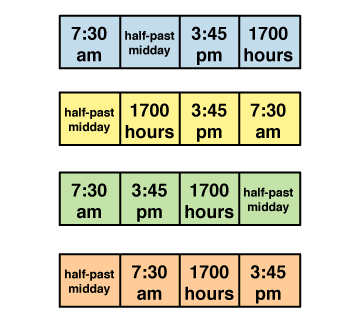 |
(only one option can be clicked) | the top (1st) option |
numeric: response boxes coded 1, 2, 3, 4 (top to bottom) |
| 2 | 1 | 1.1 | 10-19 | Which of these lengths is closest to the length of a real bath? Click on it. |
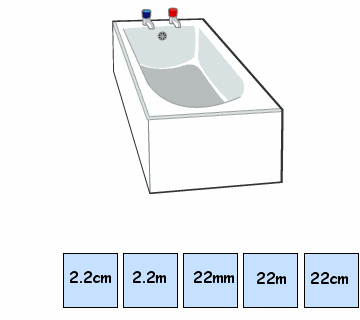 |
(only one option can be clicked) | 2.2m (2nd option) |
numeric: response boxes coded 1, 2, 3, 4, 5 (left to right) |
| 3 | 1 | 1.2 | 11-36 | Type the correct number in each box. | 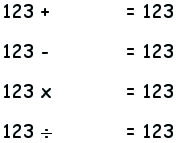 |
Only non-negative whole numbers accepted; none of the four boxes can be left blank | need all four correct: 0, 0, 1, 1 |
string: concatenated numbers as entered |
| 4 | 1 | 1.2 | 8-28 | Type the missing number in the box. 15 x 6 = 90 __ x 6 = 96 |
(no picture) | Only non-negative whole numbers accepted; cannot be left blank | 16 | numeric: number as entered |
| 5 | 1 | 1.3 | 9-38 | What fraction of the shape is shaded? Click on the answer. |
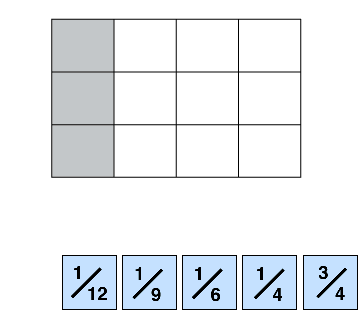 |
(only one option can be clicked) | ¼ (one quarter, the fourth option) |
numeric: response boxes coded 1, 2, 3, 4, 5 (left to right) |
| 6 | 1 | 1.3 | 12-41 | Complete the table below for the equation y = 2x - 3 |  |
Only non-negative whole numbers accepted; neither box can be left blank | need both correct answers, in the right sequence: 3, 5 |
string: concatenated numbers as entered |
| 7 | 2 | 2.1 | 14-2 | Work out the value of w by substituting c = 15 and t = 8 in the formula below. |  On screen calculator is also shown in this question |
Only non-negative whole numbers accepted; cannot be left blank | 43 | numeric: number as entered |
| 8 | 2 | 2.1 | 14-6 | Write the correct number in the box. |  On screen calculator is also shown in this question |
Only non-negative whole numbers accepted; cannot be left blank | 160 | numeric: number as entered |
| 9 | 2 | 2.2 | 8-32 | Look at the numbers. Find the number that is closest to 77 and click on it. |
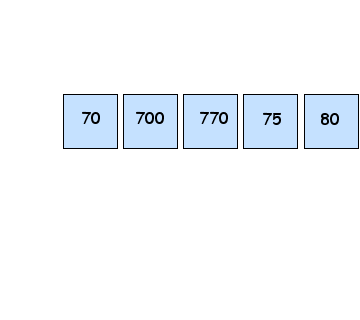 |
(only one option can be clicked) | 75 (4th option) |
numeric: response boxes coded 1, 2, 3, 4, 5 (left to right) |
| 10 | 2 | 2.2 | 11-44 | These three numbers are alike in some ways: 9, 36, 81. Click on the two ways in which they are alike. |
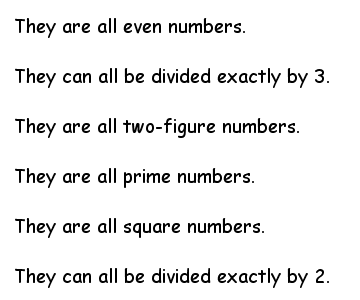 |
Exactly two responses must be selected | Need both correct: They can all be divided exactly by 3 (2nd option), They are all square numbers (5th option) |
string: concatenated responses; response options coded 1, 2, 3, 4, 5, 6 (top to bottom) |
| 11 | 2 | 2.3 | 7-3 | Find two odd numbers that
add up to 8. Type these numbers in the boxes. Remember, both numbers must be odd. | (no picture) | Only non-negative whole numbers accepted; neither box can be left blank | one of the following: 1 + 7, 7 + 1, 3 + 5, 5 + 3 |
string: concatenated numbers as entered |
| 12 | 2 | 2.3 | 14-42 | A straight line joins the point (4,6) to the point (10,18). What are the coordinates of the mid-point of the line? | (no picture) | Only non-negative whole numbers accepted; neither box can be left blank | the coordinates must be in the correct order: (7,12) |
string: concatenated numbers as entered |
| 13 | 3 | 3.1 | 14-37 | Work out the value of x. Click on your answer.  |
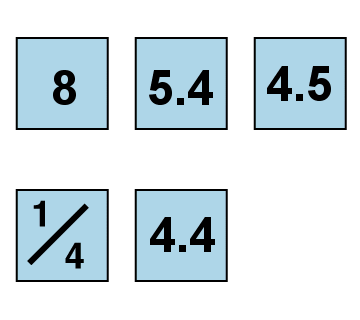 |
(only one option can be clicked) | 4.5 (third option) | numeric: response boxes coded 1, 2, 3, 4, 5 (left-to-right, top then bottom) |
| 14 | 3 | 3.1 | 13-47 | Denise has thought of two
numbers. The numbers added together make 23. The smaller number subtracted from twice the larger number makes 22. What are Denise's numbers? |
(no picture) | Only non-negative whole numbers accepted; neither box can be left blank | need both correct (in either order): 8, 15 |
string: concatenated numbers as entered |
| 15 | 3 | 3.2 | 14-48 | Look at this graph. Which one of these could be the equation for the graph? Click on your answer. 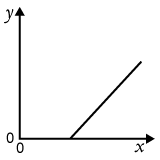 |
 |
(only one option can be clicked) | B: y = x - 2 (second option) |
numeric: response options coded 1=A, 2=B, 3=C, 4=D, 5=E, 6=F (left-to-right, top then bottom) |
| 16 | 3 | 3.2 | 14-14 | The table below shows the number of full buckets of different sizes
needed to fill a 900 litre tank. Fill in the missing value in the table. |
 On screen calculator is also shown in this question |
Only non-negative whole numbers accepted; cannot be left blank | 36 | numeric: number as entered |
| 17 | 3 | 3.3 | 14-20 | When x = 2, x + 4 is bigger than x2. When x = 3, x + 4 is smaller than x2. Find the value of x to one decimal place for which x + 4 is closest to x2. You may use this table. |
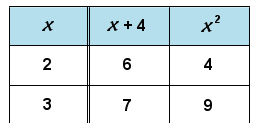 On screen calculator is also shown in this question |
Only non-negative decimal or whole numbers accepted; cannot be left blank | 2.6 | numeric: number as entered |
| 18 | 3 | 3.3 | 14-49 | Here are the first three patterns in a sequence. How many crosses are there in pattern number n? Click on the answer. 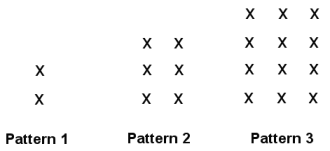 |
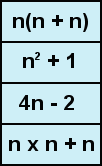 |
(only one option can be clicked) | n x n + n (4th option) | numeric: response boxes coded 1, 2, 3, 4 (top to bottom) |